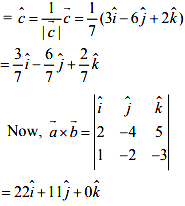Two adjacent sides of a parallelogram are given by vector a = 2i - 4j + 5k and vector b = i - 2j - 3k
Then the diagonal of a parallelogram is given by vector c = vector(a + b)
∴ vector c = vector(a + b) = 2i - 4j + 5k + i - 2j - 3k = 3i - 6j + 2k
⇒ |vector c| = √(9 + 36 + 4) = √49 = 7
Unit vector parallel to its diagonal

Then the area of a parallelogram = |vector a x vector b| = √(484 + 121 + 0) = √605 = 11√5 sq. units.